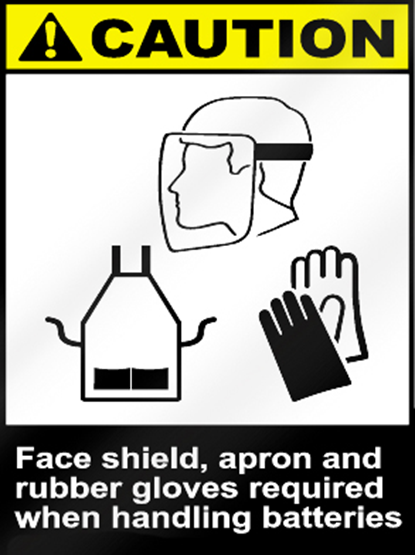Although car batteries are designed and manufactured with the highest safety measures, they remain highly dangerous while maintenance or charging. Sulfuric acid, which is the main electrochemical material of batteries, is a highly dangerous substance and one should be extremely cautious while dealing with electrolyte. Sulfuric acid can cause serious injuries to the eyes, and burn clothes and skin. For these reasons we find battery professionals wearing gloves and face shields when working. Here we list some of the safety procedures that could be taken while dealing with car batteries.
There is always a possibility that electrolyte might get on your clothes or body. In this scenario, you should immediately neutralize this burning material with baking soda and water. Other safety tips to be applied while handling batteries include:
- Always wear a face shield.
- Use a nonmetallic container to hold electrolyte.
- Stir continuously as you add small amounts of acid into water, not water into acid.
- Always connect the negative cable last and disconnect it first.
- Charge batteries only in open areas.
- Because they might explode, never charge or jump-start a frozen battery, or a damaged battery in any way
Statistically, the danger in handling batteries while shipping or installing them is less than that while charging them. There are several different methods that can be used to recharge an exhausted battery. The most secure of these is called trickle-charging. Other methods include quick-charging and slow-charging. It is always best to check the battery manual to decide on the method that may work best for your situation. A mechanic is the best and most handy solution to rely on.
Those who have cars with a manual transmission are fortuned with the ability to start their vehicles even with a depleted battery. If the charging system is in a good working condition, the driver can simply push-start the car and kick it over. A good half-hour drive is good enough to give it a solid charge. You may find the following tips helpful if you drive a manual transmission car:
- After you push-started your car, drive at a constant speed on a highway rather than a stop-and go like city driving. This will give the alternator an opportunity to charge more efficiently.
- This is an emergency; you would better turn off all accessories such as the radio and the air conditioner.
- You would have a very better chance of charging the battery if you drive during the day. Depending on the emergency principle stated in tip 2, even headlights use power and turning them off increases the amount of electricity going to the battery.
A car’s alternator is not designed to fully restore a dead battery, but rather to maintain a healthy one this is why this process does not replace charging the battery; it is only a “first aid.” Once it is handy, charge your battery on a battery charger such as the, and give it a chance to fully charge for a day or two.
On the other hand, if you have an automatic transmission system, you can jump-start the car instead of push-start it. If the charging system is in proper working condition, it will recharge quickly. The previous tips are also applicable on automatic transmission cars. As in the manual transmission, have the battery fully charged by a mechanic or charge it yourself if you own a proper battery charger.
For precautionary causes, you may disconnect the battery if you are parking your car for an extended period (more than two weeks). Remove the negative plug of the battery with a non-conductive tool, and make sure it is not touching any other parts. This will preserve the charge in your battery for the next key turn.
For more information about sell used cars, please visit



